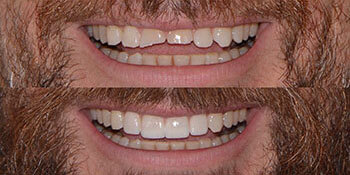Laser Dentistry Toronto
Picasso Dental Diode Laser (AMD Laser)
Laser Dentistry has rapidly emerged with a new level of quality care for patients. Dentists who have incorporated a laser into their daily practice believe that laser dentistry has long surpassed electrosurgery as a treatment option and is rapidly becoming the 21st century replacement for the scalpel. Picasso dental laser has features that can provide the clinician the ability to perform more quality procedures in less time without sacrificing patient care and comfort. Patients report that laser treatments are much gentler than those administered with an electrosurge or traditional scalpel, and result in little or no recession, swelling, less necrosis, and a quicker post-op healing process. Laser dentistry enables practitioners to manage soft tissue procedures in a clinically effective manner producing results which are generally more predictable reducing patient post-op pain and discomfort. Additionally, laser surgery is substantially less invasive therefore generates less bleeding during the procedure. Lasers are predictable, precise and produce a reduction in the need for suturing.
Lasers can be used effectively and efficiently on various soft tissue procedures including but not limited to gingival troughing, gingivectomies, uncovering implants, as well as for periodontal decontamination and desensitizing procedures, and many more. Picasso laser is also great for the treatment of canker sores, herpetic lesions and aphthous ulcers, which is proven to decrease the duration of the symptomatic period and further reduce the chance for recurrence at the same site. Picasso dental laser is also great for the use of bleaching and whitening of teeth.
PLEASE ASK DR. JENNIFER ABOUT OUR PICASSO DENTAL LASER AND SEE WHAT IT CAN DO FOR YOU.
THE FDA HAS CLEARED THE FOLLOWING INDICATIONS FOR USE OF THE PICASSO DENTAL LASER.
- Gingival troughing for crown impressions
- Gingivectomies
- Gingivoplasty
- Gingival incision and excision
- Hemostasis and coagulation
- Excision and incision biopsies
- Exposure of unerupted teeth
- Fibroma removal
- Frenectomy and frenotomy
- Implant recovery
- Incision and drainage of abscess
- Leukoplakia
- Operculectomy
- Oral papillectomies
- Pulpotomy
- Pulpotomy as an adjunct to root canal therapy• Reduction of gingival hypertrophy
- Soft tissue crown lengthening
- Treatment of canker sores, herpetic, and aphthous ulcers of the oral mucosa
- Vestibuloplasty
LASER PERIODONTAL PROCEDURES, INCLUDING:
- Sulcular debridement (removal of diseased, infected, inflamed, and necroses soft tissue in the periodontal pocket to improve clinical indices including gingival bleeding index, gingival bleeding index, probe depth, attachment loss and tooth mobility).
- Laser and soft tissue curettage
- Removal of diseased, infected, inflamed and necrosed soft tissue within the periodontal pocket.
- Removal of highly inflamed edematous tissue affected by bacteria penetration of the pocket lining and junctional epithelium.
TOOTH WHITENING INDICATIONS:
- Laser assisted whitening/bleaching of teeth
- Light activation for bleaching materials for teeth whitening
Are lasers used in dentistry?
In a surgical or dental procedure, a laser is used to treat a variety of dental problems, such as tooth decay, gum disease, lesion removal, and teeth whitening. Energy is delivered in the form of a light and acts as a cutting instrument. Lasers are also used to vaporize tissue to cut away areas of the teeth and gums that need to be removed. For example, in a root canal treatment, lasers are used to reshape the gums and remove bacteria.
In a teeth whitening procedure, lasers are used to deliver heat to the treatment area. The heat helps speed up the teeth whitening process and enhances the effects of the teeth whitening agents.
In some cases, lasers cause less pain than dental drills, which reduces the need for local anesthesia. It also reduces bleeding or swelling during soft tissue treatments and can help preserve your healthy teeth.
What is laser gum treatment?
If you have gum disease, your dentist may recommend laser gum treatment instead of non-laser surgeries, such as gum flap surgery. Laser gum treatment can also be used for dental procedures like gum contouring.
Lasers are pinpointed beams of thermal energy that are used to cut and remove the diseased gum tissue from your mouth. They can also help sterilize the area, kill bacteria, and coagulate blood vessels to form clots.
The lasers are small and pinpointed to the specific problem area. The fiber optic tip will be placed at the top of the periodontal pocket. Once the gum tissues, tartar, and calcifications are cleaned from the pocket, the laser sterilizes the tissue and bone and stimulates blood clots to promote healing.
Why get laser gum treatment?
There are many benefits of getting laser gum treatment. The first major benefit is that laser treatment is less invasive than older methods of gum surgery. Laser gum treatment is also beneficial for reaching bacteria and debris that are built up even in deep pockets. This helps thoroughly remove all the bacteria and decayed tissues that a regular dental cleaning kit can’t reach.
Lastly, laser gum treatment is precise and promotes faster healing. With the use of lasers, no healthy tissues are damaged. The lasers can accurately pinpoint the target area and only deliver treatment to that site. Since laser treatment is less invasive, you can recover faster without lots of pain or swelling.
Is laser gum treatment a good option for me?
If you’re healthy and have no pre-existing dental complications, laser gum treatment is a recommended choice for treating gum disease. If your gum disease is very advanced, your dentist may recommend another option.
What factors affect the cost of laser gum treatment?
Several factors affect the cost of laser gum treatment. One of the biggest factors is the severity of your gum disease. Other factors include the specific procedure required, complications with your teeth and gum, and the area of the gum line that needs treatment.

